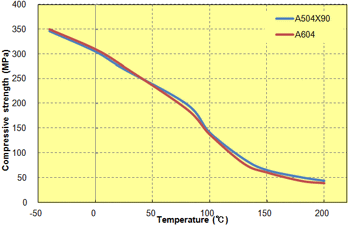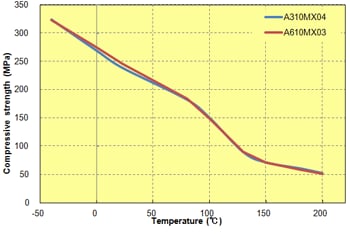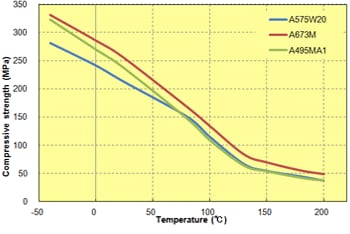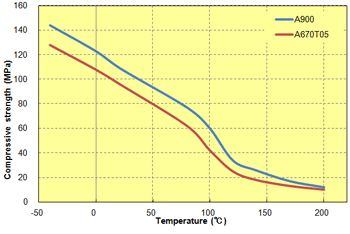- HOME
- Technical Information
- TORELINA™ PPS Resin
- Various Properties
- Mechanical Properties
- Compression Properties
Compression Properties
Ⅰ. Compression Test
 Fig. 5.46 A900 compression S-S curve (23℃)
Fig. 5.46 A900 compression S-S curve (23℃)
The compression properties are expressed by the maximum strength (stress) when a compression load is applied at a constant rate in a direction perpendicular to the cut cross-section of the test piece (machine direction). (Fig. 5.46) In the same way as for the tensile properties, the compressive strength exhibits gradual plastic deformation after the yield point is exceeded, but when a certain strain is exceeded, buckling occurs without breakage, causing the compressive strength to decrease abruptly. This buckling is peculiar to the compression tests, and occurs as a result of the influence of the elastic modulus of the material and the strain in the test piece. For unreinforced PPS, the yield strength is maximized, but for materials that have a high elastic modulus and which are thus prone to brittle fracture, such as reinforced PPS, buckling occurs before the yield point is reached, so that the buckling load is often maximized.
Table. 5.4 Compression properties of TORELINA™ (23℃)
| Item | Units | Glass fiber reinforced | Glass + filler reinforced | Elastomer improvement | Unreinforced | |||||
|---|---|---|---|---|---|---|---|---|---|---|
| A504X90 | A604 | A310MX04 | A610MX03 | A673M | A575W20 | A495MA2B | A900 | A670T05 | ||
| Compressive strength | MPa | 270 | 280 | 240 | 250 | 210 | 260 | 240 | 110 | 90 |
| Remarks | - | Buckling strength | Yield strength | |||||||
- ※Strain rate: 1 mm/min
Ⅱ. Temperature Dependence
The temperature dependence of the compressive strength of nine representative grades of TORELINA™ is shown in Figs. 5.47 to 5.50. As with the other mechanical properties, the temperature dependence of the compression properties changes greatly at and near the glass transition temperature, but the influence of the linear and cross-linked polymers is small, and the following tendency appears: The higher the reinforcement content, the higher the compressive strength at high temperatures.
 Fig. 5.47 Temperature dependence of compressive strength (GF-reinforced)
Fig. 5.47 Temperature dependence of compressive strength (GF-reinforced) Fig. 5.48 Temperature dependence of compressive strength (high-filler)
Fig. 5.48 Temperature dependence of compressive strength (high-filler)
 Fig. 5.49 Temperature dependence of compressive strength (elastomer improvement)
Fig. 5.49 Temperature dependence of compressive strength (elastomer improvement) Fig. 5.50 Temperature dependence of compressive strength (unreinforced)
Fig. 5.50 Temperature dependence of compressive strength (unreinforced)